
16 minute read
Mozart

The Mozart family. Mozart is sitting next to his sister Nannerl, with his father on the right. His deceased mother is show in a portait on the wall.
the myth and the magic
John Low traces the life and work of arguably the greatest mind in Western music
Infant prodigy, genius composer, virtuoso musician, linguist, mason, wit, dandy, billiard hustler, sometime drunkard, gambler, Johannes Chrysostomus Wolfgangus Theophilus Mozart’s life was short, highly eventful and far from sweet.
A large part of his adult life was spent begging from friends and chasing payment from his many benefactors and employers in a mainly unsuccessful attempt to maintain his and his spouse’s chaotic and profligate lifestyle.
There were periods during his Vienna years- he moved there in 1781 aged 25-when he was earning an exceptionally high salary as a freelance composer/ musician, and his subscription concerts were a roaring success. But the cash was often frittered away. He had a penchant for fine clothes and hand-made shoes: he even bought a carriage and a horse and installed a billiards table in one of the many expensive apartments they rented in Vienna. They were, to put it mildly, bad managers. Mozart’s easy- come- easy- go attitude may well be explained by the 14 Senior Times l May - June 2020 l www.seniortimes.ie
fact that he could - and , more likely had to - work at astonishing speeds and produce compositions in a fraction of the time taken by his contemporaries; and, of course of infinitely higher quality. It was not unusual for him to work through the night or operate on three hours sleep: today’s 24/ 7 ‘high flyers’, would, in comparison, be a country mile behind him. In a letter to his father he wrote, “This morning is lost in lessons, lunch is eaten at 2 pm, the afternoon is dedicated to various preparations and in the evening I finally have time to compose- as long as I have no concert to perform”.
Apart from the mental and physical strain of his composing, teaching and performing, he was his own agent, manager and general dogsbody, doing everything from booking venues, arranging advertising, printing posters and commissioning orchestras, to selling tickets.
Doro 6520 Get Active

Prepay price € 79.99
3G clam-shell phone designed specifi cally for seniors with wide set easy to use keys, short cuts to making a call, sending a message and taking a picture. Plus an Assistance Button on the back to contact friends and relatives should help be needed.
Available at
tescomobile.ie
www.doro.com
follow us on
Easy-to-read display See eveything easier on a bigger screen
Loud and clear sound Hear everything clearly, from alerts to conversations
Assistance button Send emergency alerts at the touch of a button

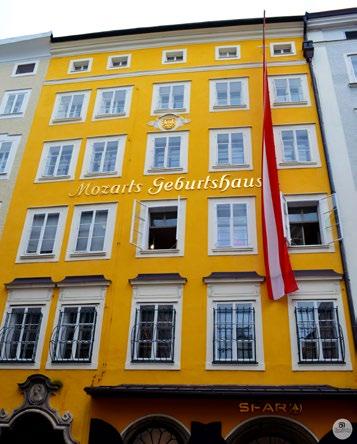
Mozart was composing at age five
The Mozarts’ house in Salzburg

German state an did not became part of Austrian empire until 1816) His father Leopold was a composer and violinist and held an official post at the Archbishop’s court in the city. His mother was Anna Maria Pertl, and he had a sister four years older called Nannerl. They were the only two of the couple’s seven children to survive infancy.
From an early age they both demonstrated remarkable musical abilities. Wolfgang would watch as his sister was given keyboard lessons. He was improvising himself for the age of three. His father began giving him lessons, and famously told a visitor to their house: “Wolfgang learnt this minuet when he was four. This minuet and trio were learnt by Wolfgang in half an hour, at half past nine at night on January 26 1761, one day before his fifth year”
Leopold, like any astute impresario, quickly realised he had a great act on his hands and paraded Wolfgang and Nannerl around Europe, almost as if they were freaks - which in some way they were freaks they wereto the adulation of Royalty , Princes of the church and the nobility. His aims were mercenary – to make money. But “The Travelling Mozarts’ enterprise was largely a financial failure.
After returning from one ‘tour’ Leopold observed sourly: “We have swords, lace, mantillas, snuff- boxes, gold cases, sufficient to furnish a shop but as for money, it is a scarce article and I am positively poor”
There were occasions when their travels produced some profit, such as when King George 111 of England paid the wunderkind the huge sum of 50 guineas to compose six sonatas for his Queen Charlotte. But like a modern touring company, putting the show on the road was an expensive business, with travel and accommodation, staff and advertising expenses. These tours, often involving traveling on poor ‘ roads’ in cold and wet carriages for weeks, with the constant fear of being held up by highwaymen, took a toll on everyone’s health and this period in Mozart’s life is often cited as a contributory factor for his later ills and early death.
Their firs important trip involved them being away from home for nearly three and a half years. And from early childhood to adolescence Mozart visited Germany, Holland, Switzerland, Slovakia, The Czech Republic, Belgium, France, Italy, and England. The travelling continued relentlessly in his adult years when he was planning, rehearsing or directing performances of his operas, or performing as a soloist. The last trip of his life was to Prague in the late summer of 1791 to the coronation of Leopold II as the King of Bohemia. In all his 35 years it has been estimated he was travelling for a period of ten years.
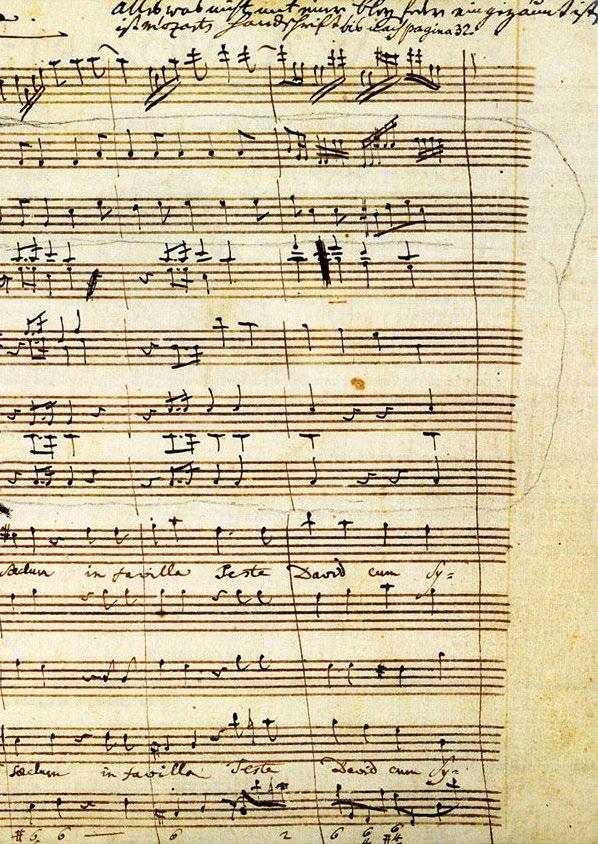
Mozart spent most of his early adult life in Salzburg composing and performing as part of his duties for the Prince Archbishop Colloredo. During this period Mozart wrote most of his liturgical works we know today; he also wrote and performed symphonies and concerts, including one of his earliest landmark works, the Sinfonia Concertante for violin and viola.
But he hated his job. He did not get on with the Archbishop and court musicians, who he found uncouth and largely incompetent. He was also becoming increasingly disillusioned with the narrow-minded, provincial attitudes of Salzburg and at every opportunity he escaped, either to seek more meaningful employment, supervise performances of his operas or perform in the more enlightened environment of cities such as Munich, Mannheim and Vienna.
It was on one or these trips to Mannheim in 1777 that he met and fell in love with talented singer Aloysia Weber, but was dissuaded by his father from pursuing the relationship until he had got himself a decent job.
Evidently Mozart had not exactly made a big impression on the young lady: he returned to Mannheim only to find that she neither remembered or recognised him! Ironically they subsequently became great friends - some suggested they may have been more than friends - when Mozart cast her in many of his operatic roles, as well as specifically composing works to display her vocal talents.
There was one consolation; shortly afterwards he was appointed Court Organist by the Prince Archbishop, with a reasonable salary. Typically this did not prevent him continuing his travels, and he was soon off to Munich. But in January 1781, he was ordered to Vienna by Colloredo who had temporarily moved his court to the Austrian capital. Mozart finally arrived in March. He was in his element, performing and socialising with the cream of Viennese aristocracy; ´For my profession this is the best place in the world’, he wrote to his father.
The Prince Archbishop ordered his court to return to Salzburg in the early summer of 1781. Not surprisingly Mozart wasn´t budging. He was having the time and success of his life, and the thought of returning to the cultural backwater that was Salzburg was inconceivable. Colloredo exploded and labelled Mozart ´ a scoundrel, an oath and a good – for – nothing´ . Mozart was dismissed by a court official. ‘I was literally kicked up the arse off the premises!’he later recalled.
And so Mozart threw himself into consolidating his rapidly growing reputation in Vienna. He was giving numerous concerts and received important commissions from private benefactors as well as the Emperor himself, Joseph II. He was also making good money by giving private music lessons to the sons and daughters of Viennese society and nobility.
Coincidentally at this time the Webers had moved to Vienna and despite his rejection by Aloysius, he had remained friendly with the family. He soon moved in as a lodger and it wasn´t long before he was courting Aloysia´s younger sister Constanze.
He married Constanze on August 4, 1782 at St Stephen´s Cathedral. He was 26, his bride 18. He wrote to his father, who disapproved of the marriage: ‘We are married now. We are man and wife! And we love each other enormously. We feel that we are made for one and other’.

Now a married man with responsibilities - Constanza quickly became pregnant- Mozart was working flat out: and with fruits of his labours, they were gradually becoming accepted into the Viennese social elite, moving to bigger and more lavish apartments and entertaining on a scale to which they were certainly not accustomed. But it was only money and there was plenty more where that came from.
The period from around 1782 onwards was undoubtedly the most lucrative for Mozart and it has been estimated that in one year he may have earned the equivalent in today´s money of more than half a million euro, if not more. It´s therefore reasonable to speculate that had he saved or invested only a modest amount of his earnings during this time, his later slide into financial ruination could have been avoided or comfortably cushioned, not to mention his early death.
His elevation into the highest echelons of Viennese society was now unstoppable. He was mixing not only with the city´s aristocracy, Austrian and European royalty but more important, with its influential and prosperous merchant classes. He met all the leading composers of the day; including Haydn with whom he became great friends. He became a mason in 1784. He had arrived.
It was also a highly productive period in which he composed many of his finest, mature works, including, piano concertos, piano sonatas, string quarters and string quintets. And of course operas, notably. The Marriage of Figaro (1786) Don Giovanni (1787), Cosi fan tutte (1790) and The Magic Flute (1791). His last three great symphonies, Nos 39, 40 and 41 (The Jupiter) – were composed in the space of six weeks in 1788. Many musicologists cite The Jupiter, with its masterly originality, invention and orchestration as his towering achievement. And considering his canon of work, that´s saying something.
16 Senior Times l November - December 2017 l www.seniortimes.ie17 Senior Times l May - June 2020 l www.seniortimes.ie And so, ostensibly, life for the Mozarts in Vienna in the mid 1780´s was pretty good. Wolfgang´s earnings were huge but so were his debts. Apart from the couple´s increasingly extravagant lifestyle there were the on-going medical expenses relating to Constanze´s many pregnancies (in all she has six children). There were, too, her routine, costly convalescence stays in the nearby fashionable spa town of Baden. Mozart was also a gambler, and although there is no firm evidence, it´s conceivable
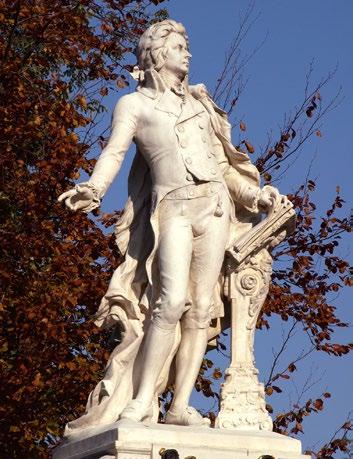
Constanze Mozart in a rare photograph from 1840
as with all gamblers- he was heavily into chasing his losses.
The begging letters start and became more frequent from 1787.
He was now seriously in debt and to make matters worse he was no longer flavour of the month with the fickle Viennese bourgeoisie. And when it seemed it could not get any worse, it did: a war with the Turkish Ottoman Empire brought a halt to all artistic activity in the city as officialdom concentrated on the war effort.
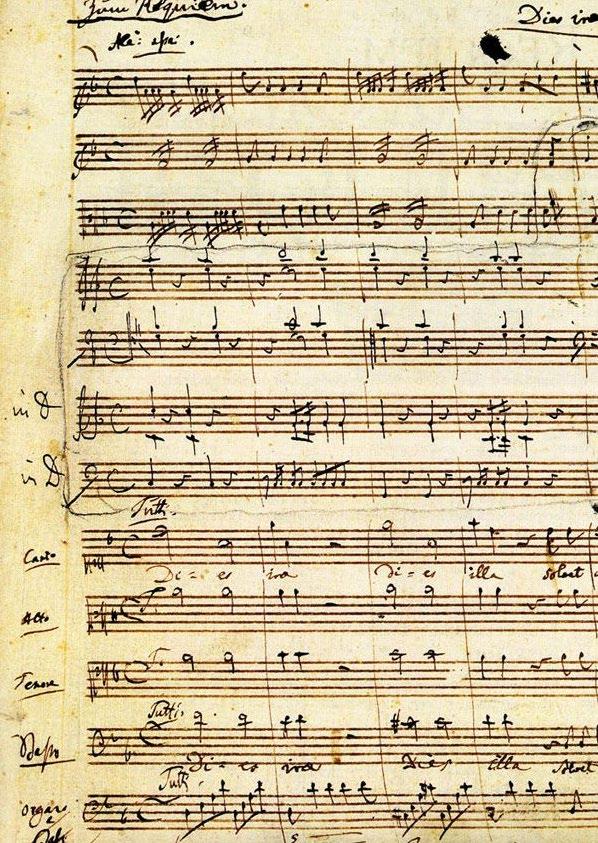
Even in the depths of despair, Mozart did not stop working, composing, among other works, the aforementioned last three symphonies the following year. Remarkably these works were not commissioned for a fee, and could have only been produced by a mind driven to transcend the musical conventions of the day.
The next two years did not bring any noticeable improvement in his financial health. He had travelled to Berlin in 1789 to try to secure a post from the King of Prussia. But without success. He had no better luck when he returned to Germany a year later for the coronation of the new German Emperor Leopold II in Frankfurt, hoping to receive serious commissions and perform at the numerous celabratory concerts.
The last year of Mozart´s life was also one of his most productive. His compositions included the operas The Magic Flute, La Clemanza di Tito, his piano concerto No. 27 a horn concerto, the sublime clarinet concerto, the Ave Verum Corpus, quintets, minuets and dances. Not to mention most of his Requiem.
His finances, too, were improving: there were offers from various European bodies to buy compositions, he had received a lucrative offer to go to London to perform and produce operas, and royalties were beginning to roll in from The Magic Flute which was a smash hit.
The legend surrounding the commissioning of his last great work, The Requiem, in the summer of 1791 is both melodramatic and fanciful; a mysterious messenger wearing a long cloak, a mask hiding his face, is said to have knocked on Mozart´s door offering part up-front payment for the work and the remainder on completion. The truth is probably more prosaic. The messenger had been sent by his master Count Franz Walsegg commissioning Mozart to write the work in memory of his wife.
Walsegg was an enthusiastic amateur composer and was known to pass off plagiarized compositions as his own. It´s likely he would do the same with Mozart’s and had probably instructed his messenger not to unduly expose himself should a connection be made.
Possibly the first signs of Mozart’s terminal illness appeared late in August during a visit to Prague when he was reported to be ‘pale’ and his expression ‘sad’. By October, according to Constanz’s recollections, he seemed to be depressed and introspective. It’s reasonable to speculate that he was physically unwell and was trying to keep it to himself- a common male trait.
By around the third week of November he took to his bed with fever and swollen joints; he was also vomiting. At this stage he had completed almost half of the Requiem and in spite of his condition he continued to compose. Towards the end he summoned his pupil Sussmayor – who completed the work – to notate his verbal instructions. It is generally accepted that he expired close to midnight on December 5th 1791 while attempting to mouth the sound and rhythm of the timpani (drum) passage. He was six weeks short of his 36th birthday.
The cause of death – theories range from poisoning to syphilis – has also given rise to speculation and legend, but the common consensus among Mozart scholars points towards kidney failure brought on by the complications of rheumatic fever.
In discussing Mozart’s burial we once again have to negotiate and sidestep the nineteenth century myth-makers. He was, we are asked to believe, buried in a pauper’s grave, with no mourners at his funeral. He was in fact ‘taken to the church’ – St Stephens Cathedral – on December 6th before his ‘economy’ funeral at St Marx Cemetery in the Viennese suburbs. The image of a neglected genius being hurriedly dumped into a common grave on a rain-lashed day, with no followers, no doubt proved irresistible to contemporary historians. But the truth is different. Mozart died in the age of The Enlightenment which challenged traditional religious values, with their emphasis on the ceremonial, and influenced the thinking of Emperor Joseph 11 who even issued a decree enforcing a ‘new simplicity’. So Mozart was not buried in a pauper’s grave, but it has to be said, only one notch above. It was also common practice at that time for mourners to accompany the corpse to the city gates and for the carriage to proceed to the cemetery where the burial was carried out by the lone gravediggers.
At the time of Mozart’s death he and Constanze had been together for ten years and in spite of their ups and downs they adored each other
A serious and introspective Mozart in the unfinished portrait by Joseph Lange, painted two years before his death. Of all the portraits Constanze said this one had best captured Mozart’s likeness.
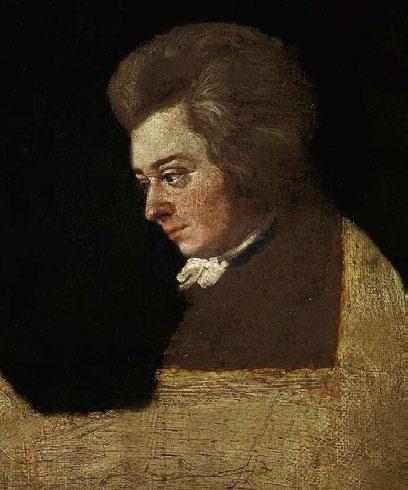
and were publicly demonstrative in their affections, often to the irritation of their friends. Certainly during their relationship they both had numer ous opportunities to be unfaithful: Mozart spent long periods away from Vienna and Constanze on his various operatic and concerts projects where he would inevitably come into contact with female instrumental and singer soloists; Constanze, for her part, would have made many male friends and acquaintances during her stays in Baden as well when Mozart was out of town.
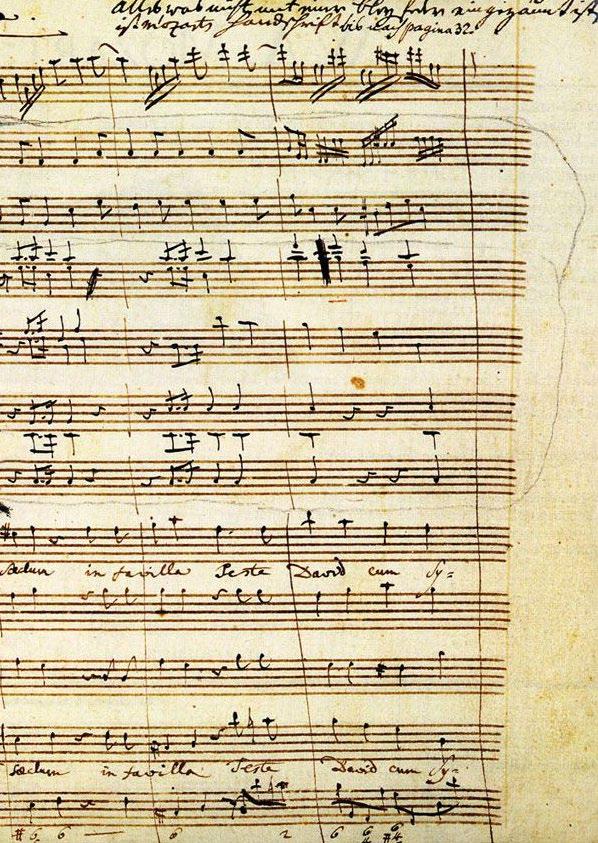
Speculation has continued over the years regarding the possibility of infidelity by one or both; but in my researches I could find no convincing evidence but concede that it might exist. A tantalising hypothesis concerns the actor and artist Joseph Lange who painted what Constanze described as the most convincing likeness in his portrait of Mozart. The work was unfinished; one theory being that the artist discovered that his wife was having an affair with Mozart and abandoned it in disgust. His wife? Aloysia Weber.
Four three-CD set of Mozart’s music from Naxos to be won

Senior Times, in association with Naxos Music, the world’s largest producer of classical music recordings, are offering four three-CD sets of Mozart’s music in this competition. Lasting two and a half hours the three CDs comprise some of Mozart’s most popular music, including concertos, symphonies, operas, piano work, chamber music, sacred works etc. This is a magnificent collection of the works of music’s greatest musical genius who started composing at the age of five.
To enter the competition simply answer this question: How old was Mozart when he first started composing?
Send your entries to: Mozart Competition, Senior Times, Unit 1, 15 Oxford Lane, Ranelagh, Dublin 6. Or email to: john@slp.ie The first four correct winners drawn are the winners. Deadline for receipt of entries is 30th May 2020










